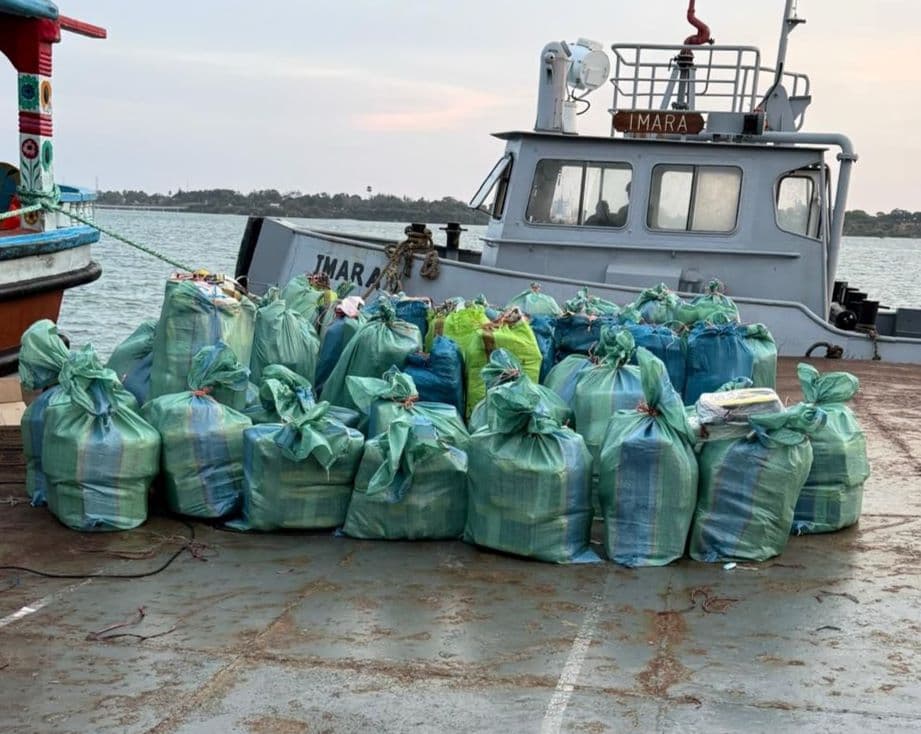We're loading the full news article for you. This includes the article content, images, author information, and related articles.
A record-breaking methamphetamine bust and the arrest of six Iranian nationals signal a dangerous escalation in the battle for Kenya's lucrative narcotics trade, a power vacuum created by the fall of the Akasha empire and the recent murder of drug lord 'Candy Rain'.

MOMBASA – A multi-agency security operation has dealt a historic blow to international narcotics syndicates, intercepting a stateless dhow in the Indian Ocean carrying what is confirmed to be Kenya's second-largest drug haul in history. The seizure of approximately 1,035 kilograms of high-purity methamphetamine, valued at Ksh8.2 billion ($63.4 million), on Saturday, 26th October 2025, has exposed the shifting dynamics of a violent underworld fighting to control the region's drug routes.
The operation, codenamed 'Bahari Safi', culminated some 630 kilometres east of Mombasa, where the Kenya Navy intercepted the vessel, identified in multiple reports as 'Igor'. Six Iranian nationals—Jasem Darzadeh Nia, Nadeem Jadgal, Imran Baloch, Hassan Baloch, Rahim Baksh, and Imtiyaz Daryayi—were arrested and subsequently arraigned at the Shanzu Law Courts on Monday, 27th October 2025. The Directorate of Public Prosecutions (DPP) has sought to detain the suspects for 30 days to complete investigations, citing the transnational nature of the crime and language barriers.
This unprecedented seizure does not occur in isolation. It marks a new phase in a power struggle that began with the dismantling of the infamous Akasha drug empire. Following their extradition to the United States in 2017, brothers Baktash and Ibrahim Akasha were sentenced to 25 and 23 years in prison, respectively, for conspiring to import heroin and methamphetamine into the US. Their conviction left a significant void in the coastal drug trade they had dominated for decades through violence and bribery.
In the wake of the Akashas' fall, Swaleh Yusuf Ahmed, notoriously known as 'Candy Rain' or 'Kandereni', emerged as a principal figure in the narcotics underworld. However, his reign was cut short. In March 2024, nine days after being abducted by individuals reportedly identifying as police officers, Swaleh's body was discovered in Kilifi, ending another chapter of the coast's drug wars. His death created a fresh power vacuum, which analysts believe international cartels are now aggressively seeking to fill.
The Ksh8.2 billion haul consisted of methamphetamine, a potent synthetic stimulant. Preliminary tests conducted by the Government Chemist confirmed the substance had a purity level of 98%, indicating the sophistication of the producers. This signals a strategic shift in the East African drug trade, which has historically been dominated by heroin trafficked from Afghanistan. The United Nations Office on Drugs and Crime (UNODC) has repeatedly warned that East Africa's 'Southern Route' is a key transit corridor for narcotics flowing from Asia to Europe and other parts of Africa.
Kenyan authorities have noted a disturbing rise in the availability and use of synthetic drugs. DCI Director Mohamed Amin confirmed the seizure as a major blow to transnational organized crime. The National Authority for the Campaign Against Alcohol and Drug Abuse (NACADA) has also raised alarms over the proliferation of methamphetamine, with CEO Anthony Omerikwa noting its detection even in some shisha establishments. This trend poses a grave public health risk, particularly to the youth.
For the residents of Mombasa, Kilifi, and Kwale counties, the battle for control of the drug market is not an abstract geopolitical issue but a matter of life and death. The influx of narcotics has fueled addiction, crime, and social decay for years. Academic studies and NACADA reports have consistently shown a high prevalence of substance abuse, including heroin, cocaine, and now methamphetamine, driven by factors like unemployment and poverty. The fight among cartels for dominance invariably spills onto the streets, threatening the security and stability of the entire region.
The successful multi-agency operation, involving the DCI, Kenya Navy, Kenya Coast Guard Service, and NACADA, represents a significant victory for Kenyan law enforcement. Interior Cabinet Secretary Kipchumba Murkomen announced on Sunday, 27th October 2025, that the government intends to publicly destroy the seized narcotics and the vessel after the suspects are charged, sending a clear message to traffickers. However, the sheer scale of the shipment is a sobering reminder of the immense challenge Kenya faces. While one major consignment has been stopped, the forces seeking to exploit Kenya's strategic location remain a persistent and evolving threat, demanding sustained national and international vigilance.
Keep the conversation in one place—threads here stay linked to the story and in the forums.
Other hot threads
E-sports and Gaming Community in Kenya
Active 6 months ago
Popular Recreational Activities Across Counties
Active 6 months ago
The Role of Technology in Modern Agriculture (AgriTech)
Active 6 months ago
Investing in Youth Sports Development Programs
Active 6 months ago